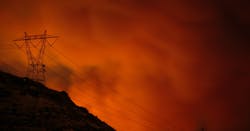Southern Cal Edison to Seek Cost, Feasibility Information for Six Microgrids
Southern California Edison (SCE) says it plans to seek cost and feasibility information from vendors soon for six possible microgrids with the intent of making a selection in March.
by Fsmelo/Shutterstock.com
The projects are in Fillmore, Fontana, and unincorporated areas of Los Angeles, San Bernardino and Riverside counties.
California’s second largest investor-owned utility described its plan in a filing before the California Public Utilities Commission, where a proceeding is underway to advance microgrids and resilience (R. 19-09-009). All three of California’s investor-owned utilities are seeking ways to quickly deploy microgrids following power outages in October and November related to wild-fire prevention. The utilities de-energized lines, a process they call public safety power shutoffs (PSPS), to prevent them from sparking.
SCE chose the six potential microgrid sites after studying 62 circuits that had to be shut off two or more times for fire safety. The utility narrowed the field down to 33 candidates based on technical criteria and then selected the final six based on the size of the low-income population in the area, number of customers served by the circuit, number of wildfire PSPS events experienced, and work needed to make the local grid ready for microgrids.
The utility expects to get cost and technical feasibility information from vendors next month, which will allow it to determine which sites are suitable for microgrids in March.
Where a full microgrid is not infeasible, or its costs high, SCE will look at alternative resiliency activities, such as temporary back-up power.
Reliability vs sustainability?
The filing points out a dilemma California faces because of the wildfire shutoffs, a possible conflict between reliability and sustainability goals. The public utilities commission wants to get microgrids installed quickly — this year — knowing the next wildfire season threatens more outages. But that may require use of microgrids with diesel or natural gas generators, since more complex microgrids with multiple green energy resources, may take more time to build.
“SCE recognizes there may be a tradeoff between these two objectives, in that an advanced fully renewable microgrid will likely require lead time beyond 2020,” SCE wrote.
Join us at Microgrid 2020, June 2-3, for a deep look at the California microgrid market. Discount registration end Jan. 31.
So SCE intends to design the microgrids in a way that allows for future upgrades or their removal when cleaner approaches are available.
“Specifically, to the extent that fossil-fueled generation is required to enable initial operation by fall 2020, SCE intends that this generation will be replaced in subsequent years with clean technology when cost-effective,” the utility wrote in the filing.
Pacific Gas & Electric (PG&E), the state’s largest utility, appears to be navigating the conflict by pursuing two different kinds of microgrids: permanent and temporary.
The temporary projects, each 4 MW and run on diesel fuel, will be designed for quick interconnection to keep services up and running for communities. PG&E plans to install up to 40 temporary microgrids at a cost of $47 million for infrastructure upgrades and $173.3 million to energize the microgrids.
Meanwhile, the permanent microgrids will be installed at 20 substations. If these microgrids require the use of natural gas, PG&E says it will arrange for delivery of renewable natural gas. The utility is soliciting bids for the permanent microgrids so their costs are not yet known. Their capacity will range from 4 MW to 69.69 MW.
California is trying to reduce fossil fuel use to cut greenhouse gases 40% below 1990 levels by 2030 and 80% below 1990 levels by 2050. The state also wants 50% of its electricity to be powered from renewables by 2025 and 60% by 2030, with the goal of 100% zero-carbon electricity by 2045.
SCE seek repeatable process
In its filing, SCE said that long term it intends to explore integration of customer distributed energy resources, such as solar and storage and controllable loads, into its microgrid projects. Adding customer resources — still an uncommon approach —”introduces a number of additional challenges and complexities, but where appropriate, such resources may eventually be incorporated into microgrid solutions,” the utility wrote.
Ultimately, SCE wants to learn how to make microgrid development a “repeatable process SCE can employ beyond 2020.”
Track new about microgrids in California. Subscribe to the free Microgrid Knowledge newsletter.
About the Author
Elisa Wood
Editor-in-Chief
Elisa Wood is the editor and founder of EnergyChangemakers.com. She is co-founder and former editor of Microgrid Knowledge.
